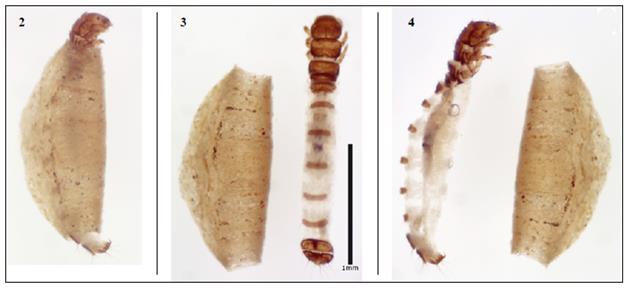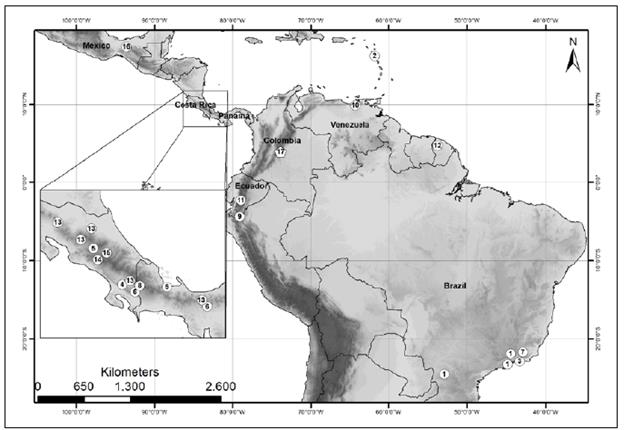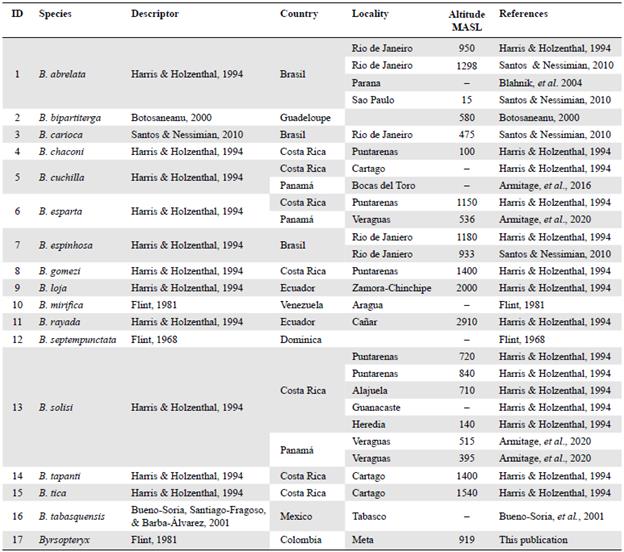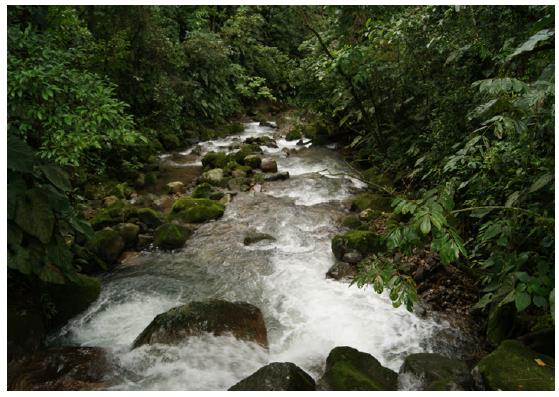Introduction
Hydroptilidae, with about 2000 described species (Holzenthal, et al., 2007), is the family of caddisflies with the largest diversity among the order (Holzenthal, et al., 2007; Holzenthal & Calor, 2017). It contains 36 genera including Dicaminus Muller, 1879, divided into six subfamilies: Hydroptilinae, Leucotrichiinae, Neotrichiinae, Ochrotrichiinae, Orthotrichiinae, and Stactobiinae (Holzenthal & Calor, 2017). In Colombia, the current register of larvae includes those from Hydroptila Dalman, 1819, Oxyethira Eaton, 1873 (Hydroptilinae), Alisotrichia Flint, 1964, Betrichia Mosely, 1939, Celaenotrichia Mosely, 1934, Cerasmatrichia Flint, Harris y Botosaneanu, 1994, Leucotrichia Mosely, 1934, Zumatrichia Mosely, 1937 (Leucotrichiinae), Mayatrichia Mosely, 1937, Neotrichia Morton, 1905 (Neotrichiinae), Metrichia Ross, 1938, Ochrotrichia Mosely, 1934, Rhyacopsyche Müller, 1879 (Ochrotrichiinae), and Ithytrichia Eaton, 1873 (Orthotrichiinae) (Table 1).
The genus ByrsopteryxFlint, 1981 belongs to the subfamily Leucotrichiinae, tribe Alisotrichiini (Santos, et al., 2016; Holzenthal & Calor, 2017) and it currently has 16 described species reported in Mexico, Dominica, Guadeloupe, Costa Rica, Panamá, Ecuador, Brazil and Venezuela (Holzenthal & Calor, 2017; Armitage, et al., 2016; Armitage, et al., 2020). We report here the first occurrence of the larvae Byrsopteryx in Colombia, in the sub-basin of the Orotoy River located in the Orinoco River's macro-basin, which is also the first record of this genus for Colombia.
Materials and methods
Study site
The Orotoy River runs through the municipalities of Acacías, Castilla La Nueva, Guamal, and San Carlos de Guaroa, department of Meta (Colombia), on the eastern flank of the Oriental Andean Cordillera. The river is born at an altitude of 1.620 MASL, it is 54.5 km long, and drains into the Orinoco River basin (Caro, et al., 2011). The precipitation is unimodal with two distinctly marked periods: the dry season goes from December to March and the rainy season from April to November (Ramírez-Gil & Ajiaco-Martínez, 2001, 2011; Ramírez-Gil, et al., 2011).
Data collection
The caddisfly larvae was collected with a Surber net (350 um mesh size) at the site El Recreo (3°57'18,8'' N, 73°50'44.4''W) located 919 MASL in April 2011 (precipitation period of transition to high water). The channel was characterized by riffles, a width between 5.0 and 6.30 m, an average depth of 0.37 m, and a discharge of 0.315 m3/s. The bottom channel is composed of metamorphic rock and clay-loam soil while the bank shows the secondary forest characteristic of Meta's tropical foothill wet zone biome (Romero, et al., 2004); changes in longitudinal and transversal continuity due to expanding areas for livestock were observed. In that portion, the channel is cascade type (Montgomery & Buffington, 1997) with a fast-flowing stream running over rock and pebbles exposed to light (Figure 1). Larvae was living on rock surfaces occasionally above the waterline. The water temperature was 19.7°C, slightly acidic (pH 5.8), with a high dissolved oxygen content (9.1 - 9.7 mg/1 O2), and low conductivity (15.6 μS/cm).
Identification
The taxonomical identification of the larva genus was done by consulting the literature (Angrisano & Sganga, 2009; Santos & Nessimian, 2010; Springer, 2010) and the experts Paola Alejandra Rueda Martín (CONICET, Argentina) and Monika Springer (Universidad de Costa Rica). The collected specimens were deposited in the macroinvertebrates biological collection (CZUT-Ma-15061) at Universidad del Tolima. The collection license for zoological material was provided by Corporación para el Desarrollo Sostenible del Área de Manejo Especial La Macarena (CORMACARENA) (file PM.GA. 3.37.19.010.002 - Resolution PS.GJ.1.2.6.11).
Results and discussion
This is the first record of Byrsopteryx larvae in Colombia. The specimen we analized had the characters proposed by Flint (1981), Harris & Holzenthal (1994), Angrisano & Sganga (2009), Santos & Nessimian (2010), and Springer (2010): brown head; no pigment around the eyes (Figure 2); 9 mm-long setae (Figure 2); pronotum with middorsal ecdysial line and a pair of anterolateral depressed areas; meso- and metanota without them; pro- and mesonota with transverse mesal line (Figures 3,4); all pairs of legs with similar short and stout structure (Figure 4); slightly enlarged but not compressed or depressed abdomen (Figure 3); nine abdominal segments with sclerotized tergites and variable size (Figure 3); each of the segments III to VII with wide and short tergite; segments VIII and IX heavily sclerotized forming together a large circular operculum that closes from the posterior margin to the anal proleg (Figure 3); short anal proleg (Figure 2,4); free-moving larval case made of silk with bits of sand and mineral material, laterally depressed and slightly undulatory, and round anterior and posterior openings directed slightly ventrally (Figures 2,3).

Figures 2-4 Larvae of Byrsopteryx. 2: Individual inside of refuge. 3: Dorsal view of larvae; pro-, meso- and metanotum characteristics; abdominal segments VIII and IX heavily sclerotized. 4: Lateral view larvae; abdominal segments with sclerotized tergites dorsally. Photos by J.I. Rojas-Pena. All photos at the same scale
This Byrsopteryx larva record for Colombia completes the distribution of this genus in the north part of the South America region. It had been reported before in México, Dominica, Guadeloupe, Costa Rica, Panamá, Ecuador, Brazil, and Venezuela (Holzenthal & Calor, 2017; Armitage, et at., 2016; Armitage, et al., 2020) (Figure 5-Table 2). The localities where they were collected are more or less conserved, the streams were exposed to light and had rock areas, riffles, and splatter zones (Flint, 1981; Harris & Holzenthal, 1994; Botosaneanu, 2000; Santos & Nessimian, 2010). Which are similar to the site in the Orotoy river; however, it is the first time that they are reported in this physical and chemical parameters. The research on adult specimens of the order Trichoptera in the country has been scarce (Mey & Joost, 1990; Flint, 1991; Rincón, 1999; Muñoz-Quesada, 2000, 2004) (Table 1) and the efforts have focused on determining the ecological and taxonomic aspects of caddisflies larvae in Andean mountains (Ballesteros, et at., 1997; Posada-García & Roldán-Pérez, 2003; Latorre-Beltrán, et al., 2014; López, et al., 2015; Mosquera-Murillo & Córdoba-Aragón, 2015; Serna, et al., 2015). However, caddisflies from one of the largest regions in Colombia (Orinoquia) have not been studied (Moreno-Rodríguez, et al., 2017). Recently, Longo, et al. (2013) study in running waters in that region reported for the first time genus Blepharopus Kolenati, 1859 (Hydropsychidae) larvae.

Figure 5 Geographic distribution of Byrsopteryx. See Table 2 for numbers (17. New record, this study)
Table 2 Byrsopteryx species of the Neotropical region (according to Holzenthal & Calor, 2017 and others).

The research on the diversity of the Trichoptera order in Colombia has to increase. This record is evidence of the possibilities of studying the Trichoptera order at ecological and taxonomical levels and of the need to conduct faunal studies determining larvae-adult association to know which species are present in the region.

















